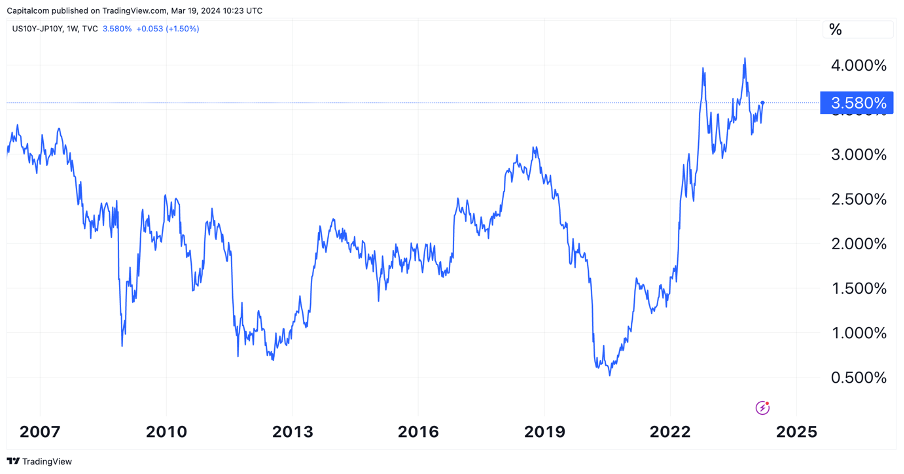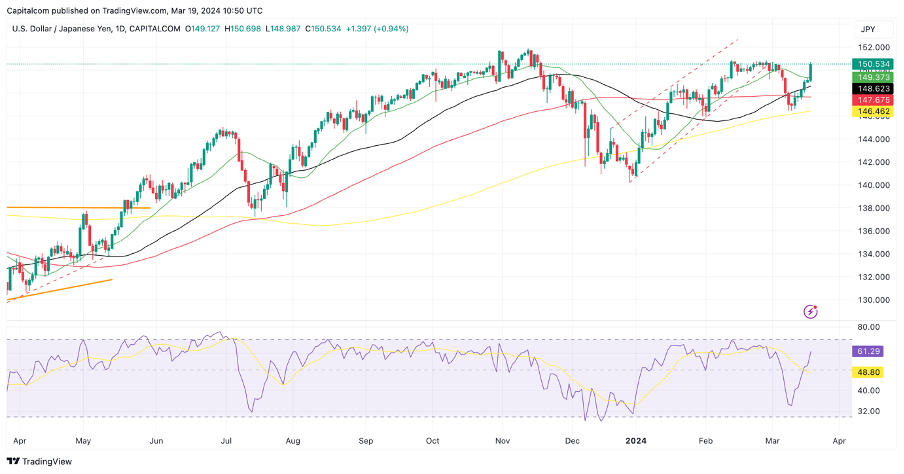USD/JPY returns to 150 despite BOJ rate hike, FOMC in focus
The BOJ raises rates for the first time in 17 years but keeps policy accommodative
USD/JPY is toying with the 150 mark once again, despite the Bank of Japan ending its negative rates policy in its meeting overnight. This is the bank’s first rise in 17 years. On top of raising rates from -0.1%, the BOJ is abandoning its yield curve control policy, which involved intervention to ensure the yield on 10-year government bonds remained below 1%.
Japan had struggled with deflation for a whole generation, meaning policymakers had to implement strict quantitative easing measures, but after a few failed attempts wages are finally rising. Consumer prices have risen beyond the target, and not only because of external factors.
However, the central bank isn’t yet comfortable about the stability of the Japanese economy, saying that largely accommodative monetary conditions will remain for the time being. This weighed on the Japanese Yen. The market reaction has also been limited because there was somewhat of a lack of surprise given that Japanese officials had already hinted at the end of negative rates a few days earlier. Moreover, the fact that Japanese rates have returned to neutral territory does not negate the fact that the BOJ still has the lowest policy rates in the world.
US-Japan 10-year yield differential

Past performance is not a reliable indicator of future results.
Looking at yield differentials, the gap between Japanese and US treasuries remains wide. The fact that the rate hike is seen as a one-time thing has caused the market reaction to be limited, with the Yen trading weaker across the board. The fact that markets had already anticipated the decision removed much of the surprise. However, Governor Ueda’s dovish comments after the meeting were enough to end any post-decision bullish sentiment in the Japanese currency.
The carry trade versus the major currencies continues to be in play and is expected to continue for a while. This means the Yen is likely to see further weakness, especially if the other central banks continue to delay cutting rates.
A key event this week will be the Federal Reserve meeting on Wednesday. The latest inflation readings coming in higher-than-expected have pushed back on expectations about rate cuts, allowing the US dollar and yields to recover some lost momentum over the past week. The stronger USD is also clouding the potential appetite in JPY, and it's likely to continue this way in the coming days if the Federal Reserve continues to push back on the start of the rate-cutting cycle.
USD/JPY is now facing resistance at the highs seen last month. Pushing beyond 150 is usually seen as a tricky task given it has prompted FX intervention from Japanese officials in the past. For now, 150.90 remains the immediate high to beat, but a stronger USD over the coming days could potentially push the pair further towards 152, with the 2023 high potentially offering resistance at 151.92.
USD/JPY daily chart
 Past performance is not a reliable indicator of future results.
Past performance is not a reliable indicator of future results.